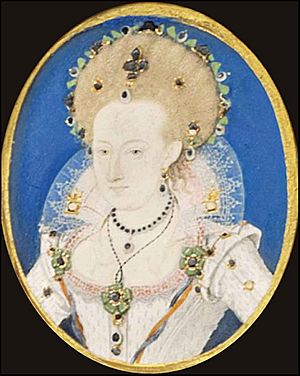Jewels of Anne of Denmark facts for kids
Anne of Denmark (1572–1619) was the wife of King James VI of Scotland, who later became King James I of England. She was queen of both Scotland and England. We know about her amazing jewels from old records and paintings by artists like Paul van Somer. A few of her actual jewels still exist today. Some historians prefer to call her "Anna," which is how she often signed her name.
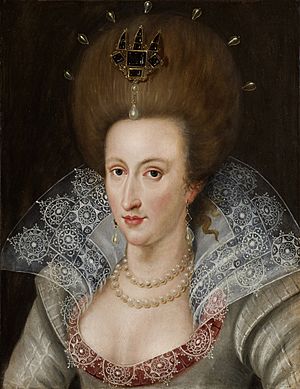
Contents
Jewels and Goldsmiths
Queen Anne owned many beautiful jewels. She worked with skilled goldsmiths and jewellers to create new pieces and care for her collection.
Royal Wedding Jewels
Anne of Denmark and James VI were married in 1589. First, they had a ceremony where someone stood in for James. Then, they met in person in Oslo. For their engagement, Anne received a special diamond ring. It was a large gold ring with five diamonds, called the "espousall ring of Denmark."
This ring and another gold jewel with the letters "J.A.R" (for James, Anne, Rex/Regina) in diamonds were very important. King James brought them to England in 1603.
Before James left for Denmark, his goldsmiths returned some royal jewels they had held as security for loans. While in Denmark, James gave jewels as gifts to Anne's family, including her brother Christian IV. These gifts included large diamonds and rubies set in gold rings.
Anne's Arrival in Scotland
When Anne arrived in Scotland in May 1590, the city of Edinburgh held a grand welcome ceremony for her. As she entered the city, a rich jewel was lowered to her from the Netherbow Gate. This jewel had a large emerald and diamond set in gold, with pearls hanging from it. It had been remade from an older royal jewel. The jewel was called the "A," likely for Anne's initial.
Soon after her coronation, Queen Elizabeth I of England sent an ambassador with gifts for Anne. These included a fancy cloak with jewels, a pearl necklace, and a watch.
Jacob Kroger, the Jeweller
Anne brought a German jeweller named Jacob Kroger with her to Scotland in 1590. He made fastenings and buttons for her clothes. Sadly, Kroger later tried to run away to England with some of the queen's jewels. He was caught, brought back to Edinburgh, and executed.
Gifts for Prince Henry's Baptism
In December 1593, when Anne was pregnant, King James gave her many of his own jewels. This may have included a large diamond and ruby pendant called the "Great H of Scotland," which had belonged to Mary, Queen of Scots.
Her son, Prince Henry, was born in February 1594. In April, James gave Anne a gold headdress with two rubies and 24 diamonds, and an opal ring.
In August 1594, Prince Henry was baptised at Stirling Castle. Anne's grandfather sent her a beautiful gold necklace. It had rubies, chrysolites, and hyacinths set in roses. This necklace was described as "antique," meaning it was made in a modern, classic style. It was meant to be worn on the front of a gown, like the French fashion Anne liked.
Another ambassador brought a miniature portrait of his master in a locket. This locket had the duke's name in diamonds. It also showed a scene of Diana and Actaeon, with Actaeon's blood shown by polished rubies.
New Year's Day Gifts
It was a tradition in Scotland to give gifts on New Year's Day. In January 1596, King James gave Anne gold bracelets with stones and pearls, a ruby ring, and a diamond and ruby necklace. These gifts were bought from a goldsmith named Thomas Foulis. The money came from a payment James received from Queen Elizabeth I.
Anne also had clothes embroidered with pearls. In 1597, she ordered a gown with jet beads and buttons, but it was too heavy to wear!
In later years, James continued to give Anne jewels. In January 1600, he gave her a large emerald surrounded by diamonds and another jewel with 29 diamonds.
George Heriot, the Queen's Goldsmith
George Heriot became the Queen's goldsmith in 1597. He sold many pieces to Anne of Denmark. He also provided embroidered clothes and hats for the queen and her children. One item was a diamond feather with an emerald for a hat.
A necklace that still exists today, thought to be made in Edinburgh, looks like designs from a German jeweller who worked for Anne's brother, Christian IV. This shows how fashion was connected between the royal courts of Scotland and Denmark.
Heriot and Royal Loans
George Heriot often loaned money to Anne of Denmark, and she would use her jewels as security. In 1601, he returned a ruby and diamond feather that she had pledged for a loan. Anne once wrote to him asking for £200 quickly because she needed to leave right away.
King James also borrowed money from Heriot, sometimes using his own jewels as security. In 1603, Anne pledged a jewel with 73 diamonds and two emeralds to Heriot for a debt of over £7,500 Scots. Even after moving to England, she continued to get jewels and loans from Heriot.
A gold cross with seven diamonds and two rubies, pawned by Anne in 1609, may have belonged to Mary, Queen of Scots and her mother. In 1613, to pay for her trip to Bath for her health, Anne pawned a "fair round jewel" with a diamond for £1,200.
Heriot in England
Heriot's bills for jewels supplied to Anne in England from 1605 to 1615 added up to about £40,000. Her servants often helped her deal with Heriot and make payments. These servants also looked after the jewels Anne wore and helped her get dressed. When she travelled, her jewels were kept safe by a special clerk.
Heriot made at least four diamond-set anchor jewels for Anne. He also made a chain of gems and pearls with her miniature portrait, which Anne gave to the Spanish ambassador in 1605.
Surviving Jewels and Designs
Some pieces made by Heriot for Anne still exist today. These include a gold miniature case with her initials in diamonds, now at the Fitzwilliam Museum. She might have given this to her lady-in-waiting, Anne Livingstone.
Another surviving piece is a pair of earrings with the enamelled face of an African man. Heriot described them in 1609 as "two pendants made as more's heads and all sett with diamonds price £70." Anne also had "a pendant with a Moore's head." She had African servants, and these jewels might show her interest in how African people were shown in plays, like her own The Masque of Blackness.
Jewels with Initials
Heriot and other goldsmiths made jewels for Anne with initials in diamonds. These included "S" for her mother, Sophie of Mecklenburg, "C4" for her brother Christian IV, and "AR" for herself (Anna Regina, meaning Queen Anne). Christian IV even sent Anne a diamond "C4" in 1611.

These initial jewels appear in Anne's portraits, especially those by Paul van Somer and Marcus Gheeraerts the Younger. Portraits of other women in her court also show jewelled lockets with "A," "AR," or "R" for "Anna Regina."
The miniature case at the Fitzwilliam Museum has two monograms: "CAR" and "AA." It also has a special "S" symbol, called the "s fermé," which was used as a sign of affection. This "S" also referred to Anne's mother, Sophie. The case also has a "CC" for Christian IV.
In 1620, King James gave one of Anne's lockets to an ambassador. It had diamonds and portraits of the king and queen, and their daughter Elizabeth and her husband. This kind of jewellery showed family connections.
Other Goldsmiths and Gifts
Anne also bought jewels from other goldsmiths in Edinburgh, like Thomas Foulis. He supplied her with bracelets and diamond necklaces as New Year's Day gifts from the King. Foulis also bought a sapphire with Queen Elizabeth's portrait for Anne in 1598.
In England, other goldsmiths supplied Anne, including William Herrick and John Spilman. Spilman made a diamond jewel with the "AR" cipher, which Anne gave as a gift. Nicholas Howker made a chain of green enamelled gold snakes with diamonds, which Anne gave to the Spanish ambassador.
Anne also gave jewels as gifts at christenings. She gave a diamond ring to her lawyer and his wife.
Moving to England and Queen Elizabeth's Jewels
In 1603, when King James became King of England, he travelled south to London, leaving Anne in Scotland. There were rumours that Anne had given away many jewels and clothes to her ladies in Scotland.
King James wanted Anne to look like an English queen when she crossed the border. He ordered some of Queen Elizabeth I's jewels and a hairdresser to be sent to Anne. He also told her not to wear mourning clothes for Elizabeth.
Anne had a disagreement at Stirling Castle about her son, Prince Henry, and she had a miscarriage. The Duke of Lennox brought Anne four of Queen Elizabeth's jewels to help calm things down. Anne thanked James for "your four jewillis."
In May 1603, a group was chosen to list Elizabeth's remaining jewels. The most suitable ones were kept as crown jewels. The rest were returned to Elizabeth's former keeper.
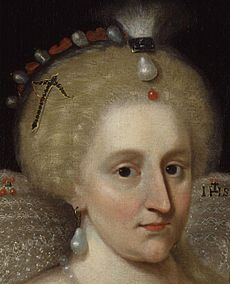
King James chose a diamond-set gold crossbow jewel from Elizabeth's collection. Anne was later painted wearing a crossbow jewel in her hair. This symbol might have meant that cleverness is better than brute strength.
Jewels were brought from the Tower of London for Anne. She arrived in York in June 1603. James sent a chain of pearls to their daughter, Princess Elizabeth. Anne liked the pearls so much that she swapped them for a set of ruby buttons, which might have belonged to Mary, Queen of Scots.
Anne usually wore a face mask to protect her skin when travelling. But in June 1603, she rode towards London without a mask so her new subjects could see her.
The Coronation Circlet

Anne's coronation as Queen of England was on July 25, 1603, at Westminster Abbey. She was given a special jewelled circlet, made by London goldsmiths John Spilman and William Herrick. This circlet used gemstones from Queen Elizabeth's old jewels. The cost for making it was £150.
The coronation service mentioned that her hair would be loose, with the circlet on her head. The circlet was described in detail in 1630: it had eight large diamonds, rubies, emeralds, and sapphires, with many smaller diamonds, rubies, and pearls.
However, some reports said she wore a plain gold band. But a German diplomat described her wearing a heavy coronet with precious stones. She was crowned with one of Elizabeth's "wearing crowns." The new circlet was later added to the Crown Jewels.
Jewels at Court
In January 1604, a diamond jewel with a pearl pendant was featured in a play called The Masque of Indian and China Knights at Hampton Court. King James bought it for £760. He also bought another jewel with a large ruby and two diamonds, trading some of Queen Elizabeth's old jewels for it.
In December 1607, King James gave Anne four special items from the Jewel House. These included a cup made of unicorn's horn (believed to protect against poison), a gold jug, a salt shaker with sapphires and "serpent's tongues" (fossilized shark teeth, also thought to protect against poison), and a crystal chess board.
The Masque of Beauty, performed in January 1608, was famous for its dazzling display of jewels. People said that even ladies of lower rank wore jewels worth over £100,000. Anne of Denmark and Arbella Stuart wore jewels worth even more. Anne wore a necklace with the initials "P" and "M," which had belonged to Mary I of England.
Anne also had a chain given to Queen Elizabeth by the Earl of Leicester in 1584. Anne later gave it to her daughter, Elizabeth. Another necklace spelled out a Latin motto: Gemma preciosior intus (a greater jewel within).
Ambassadors and Gifts
Ambassadors often described Anne of Denmark's magnificent appearance. In November 1603, Venetian diplomats saw her at Wilton House, covered in jewels and strings of pearls. In August 1604, the Constable of Castille saw her at Whitehall Palace, sitting on a throne decorated with rubies, emeralds, and hyacinths.
The Venetian ambassador, Zorzi Giustinian, said that the pearls and jewels worn by the queen and her ladies at The Masque of Beauty were amazing. He thought no other royal court could match such a display. In 1613, another ambassador admired her pearls at Princess Elizabeth's wedding, saying she wore "the most beautiful in the world." She wore so many diamonds on her white satin dress that she seemed to be on fire. Her jewels were thought to be worth £400,000.
In December 1617, a chaplain described Anne at Somerset House. She wore a pink and gold dress with a wide farthingale (a hoop skirt). Her hair was styled with diamonds and other jewels, spreading out like rays or sunflower petals.
Ben Jonson, a famous writer, described the jewels at The Masque of Beauty in 1608. He said the performers' jewels and clothes were so rich that their throne looked like a "mine of light."
Anne and her ladies-in-waiting received gifts from ambassadors. In 1603, French ambassadors gave her a crystal mirror in a gold box with diamonds. They also gave gifts to her ladies, including a pearl and diamond necklace.
In 1604, the Constable of Castile brought jewels from Antwerp as gifts for the English court. He gave a gold anchor with 39 diamonds to Lady Anna Hay and a diamond aigrette to Jean Drummond. At a banquet, he drank from a crystal and gold cup shaped like a dragon, which was displayed on the queen's table. Anne's dragon cup showed symbols from her family's coat of arms. She gave the Count a diamond box and a stomacher (a decorative front piece for a dress) with large pearls for his wife.
In 1605, Anne sent embroidered waistcoats and pillowcases to the Infanta Isabella Clara Eugenia in Brussels. After the Gunpowder plot, the Queen of Spain sent Anne a Spanish-style satin robe with gold tags and chains of gold beads filled with scented ambergris. Scented items were a common diplomatic gift. In 1604, the Queen of France sent Anne a cabinet with musk and ambergris to make a "sweet savour." It had drawers full of flowers and other jewels for hair.
In May 1613, Anne went to Bath for her health. The ambassador of Savoy tried to follow her with a gift of a crystal casket, but he returned to London. He had brought lions and other live animals for King James!
Decorative Arts: Tableware and Clocks
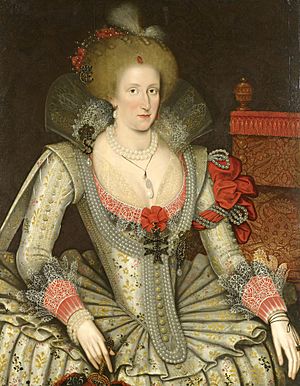
A goldsmith named John Williams made a silver-gilt fountain for Anne. It had mermaids and "wild men" (who were symbols of the Danish royal family). This fountain was used at Somerset House, which was also known as "Denmark House."
At Denmark House, Anne had a green enamelled palm tree with a crown. It had a Latin poem about her fruitfulness as the mother of the Stuart kings. The poem was written by her secretary, William Fowler. The palm tree was admired by visitors. It seems this object was a salt shaker combined with a clock.
Another unusual clock at Denmark House was shaped like a silver-gilt tortoise. It had pearls and emeralds and a clock inside its body.
In 1605, when Anne was pregnant with Princess Mary, she stayed at Greenwich Palace. She received a magnificent display of gilt plate. She kept a crystal jug with a phoenix on top. After Princess Mary was born, King James gave Anne a diamond jewel and two dozen buttons worth £1550. In 1612, Christian IV sent her a mirror framed in gold with diamonds, pearls, and other jewels.
In 1625, some of Anne's jewels and plate were sent to the Duke of Buckingham to be sold or pawned. These included a gold basin and ewer with diamonds, a jewelled bowl with a wild man figure, and a standing cup with jewels and the Danish coat of arms.
The 1606 Jewel List
A detailed list of Anne's jewels from 1606 is kept at the National Library of Scotland. It includes over 400 items, like pieces from Queen Elizabeth and gifts from King James and Christian IV. It's not clear if any belonged to Mary, Queen of Scots. The list shows how the jewels were stored in numbered chests.
Notes on the list show that many pieces were taken apart to use their gems in tableware. These pieces were often given as gifts to ambassadors. A pearl necklace was given to Anne's daughter, Princess Mary. After the child's death, it was given to her nurse.
A "feather" jewel was not highly valued because its stones were topazes, not real diamonds, and its pearls were Scottish. When it was taken apart for its gold, the topazes were saved to show the queen. Diamonds were taken from three bracelets to make new tags for clothes.
An "attire" for the queen's hair was described in detail. It was a wire frame with silk hair, having eleven "spriggs" (spikes), each with a large pearl. A portrait medal of Anne shows her jewelled hairstyle. Her young companion, Anne Livingstone, also bought a similar wire hairpiece.
A portrait of Anne by Paul van Somer shows a large diamond in her hair, possibly the "Portugal diamond" or "Mirror of France." This diamond was acquired by Queen Elizabeth and later used by Anne. King James wore the Portugal diamond on his hat in 1603.
The 1606 list mentions the "Portugal diamond" set in gold with a silk lace and a pearl pendant. It notes that a goldsmith added a gold pin. Drawings of the Portugal diamond and another pearl were made later by a jeweller in the Netherlands.
Jewels with scenes of the Annunciation (when an angel told Mary she would have a baby) and Diana with nymphs and Actaeon were listed together. The Annunciation jewel was given to Anne Livingstone. The Diana and Actaeon jewel was taken apart in 1609 to make a basin and ewer.
Another jewel, taken apart in 1610, showed a woman on the back of a monster that was half man and half dragon.
The Mirror of Great Britain Ruby
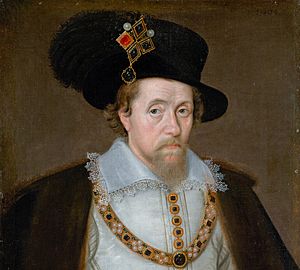
King James gave Anne of Denmark the ruby from his famous jewel called the 'Mirror of Great Britain' as a New Year's Day gift in January 1608. It was set in a feather ornament with 28 small diamonds. The ruby in the 'Mirror of Great Britain' might have been replaced by a diamond to make it look symmetrical.
Jewels and Drawings
In July 1610, Anne of Denmark visited the Jewel House herself to choose jewels. A letter from 1618 gives an idea of how jewels were ordered and old pieces reused. It was sent to Arthur Bodren, a French servant who kept accounts for the queen.
The letter mentioned a drawing for a new jewel. The writer went to the royal Jewel House to find suitable jewels and rubies for the new piece. An old diamond bracelet had the right size stones. However, the goldsmith had already used most of the suitable rubies for gold plate for the table. He found a "border" with larger diamonds to send to the queen for her approval. The queen had thought the diamonds in the original drawing were too small.
A note in the 1606 list identifies a diamond "girdle or border" as the piece chosen for Bodren to send to Anne at Hampton Court in 1618.
In March 1615, Anne of Denmark pawned some of her most valuable diamonds for £3,000. The goldsmith John Spilman made drawings of these eleven stones.
What Happened to the Royal Collection?
During her lifetime, Anne gave jewels to her friends and supporters. Jewels given by Anne are mentioned in wills and inventories of the time. For example, in 1640, a Scottish Laird had a round gold jewel with 29 diamonds and four large rubies, which Queen Anne had given to him in 1607 to wear in his hat.
Anne did not leave a will saying who should get her jewels. Before she died, her son Prince Charles asked her to make a will, leaving her jewels to him, which did not please King James. However, a lawyer noted in 1619 that Anne wanted her "rich stuff, jewels, and plate" to become part of the Crown Jewels.
After her death in April 1619, a list of her jewels and plate was made. Anne played the virginals (a type of keyboard instrument), and one of her instruments had a green velvet case embroidered with pearls. Soon after the list was made, two of the queen's servants were accused of stealing jewels and were taken to the Tower of London. George Heriot provided drawings of missing jewels he had supplied, which were said to be worth £63,000.
King James ordered some of Anne's less important items to be sold in July 1619, including old fabrics and gowns. Some "jewels, precious stones, plate, and ornaments" had already been sold. The sales included "loose and ragged pearls," broken silver, old linen, cabinets, and old robes of former queens. Anne's collection even included some of Henry VIII's clothes.
In March 1623, King James asked for a selection of Anne's jewels from the Tower of London, especially her fine pendant diamonds and jewels "fittest for the wearing of women." These and other jewels were sent to Spain in 1623, including the "Portugal diamond." A list made in May 1625 showed a chest of her remaining jewels, including the circlet, the crown used at her Scottish coronation, and a headpiece with nine large pearls.
Charles I gave his daughter, Princess Mary, a crystal bottle with rubies and diamonds, and a chain with his mother's "AR" cipher, for her wedding in 1641.
Jewel Thefts
Anne of Denmark's servants were accused of stealing her jewels several times. Jacob Kroger in 1594, Margaret Hartsyde in 1608, and Piero Hugon and "Dutch maid Anna" in 1619. "Dutch maid Anna" was likely Anna Kaas, a favourite servant who was said to have received Anne's valuable linen after her death.
In 1621, a chest of the queen's jewels was found at Denmark House. Thirty-seven diamonds from these "secret jewels" were used to decorate a miniature of King James sent to Elizabeth of Bohemia. This discovery might be connected to the earlier theft by Piero Hugon and Danish Anna.
Images for kids
-
Princess Elizabeth, around 10 years old, wearing a wire-framed hair ornament.


